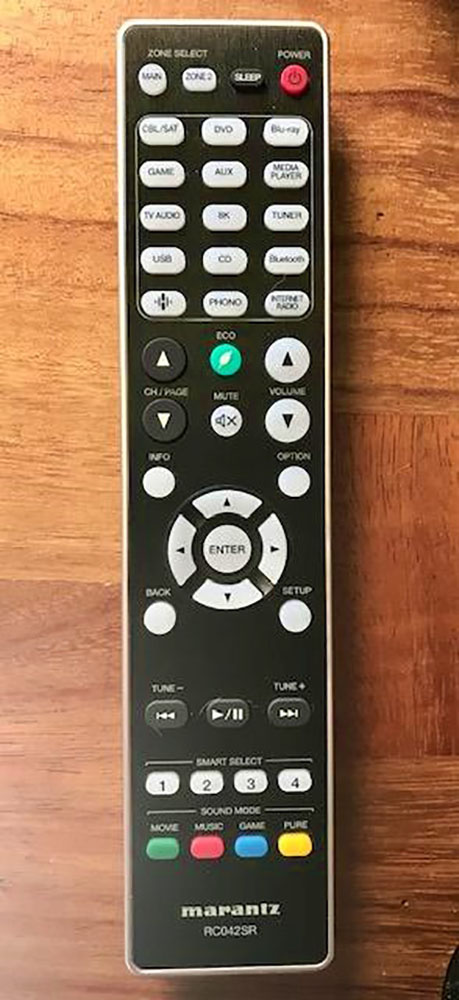
My first piece of audiophile equipment was a Marantz 2226B stereophonic receiver that I got right after college in 1980. It had a cool flywheel tuning dial and sweet looking blue diode lights. Even with my low-budget speakers, it sounded great. Fast forward to the present and the only similarity is the name and Saul Marantz’s philosophy of having the music sound like music. Yes, the top-notch sound quality that Marantz has always been known for is still there.
Marantz SR6015 AV Receiver
- Dolby Atmos®, Dolby Atmos Height Virtualization Technology, DTS: X® and DTS Virtual: X™ and IMAX®
- Nine amplified channels with two independent subwoofer outputs
- Can be used as an 11.2-channel processor by disconnecting the internal amps
- eARC and HDMI 2.1 for uncompressed audio from your smart TV and 4K or 8K video upscaling on all seven HDMI ports
- Audyssey MultEQ XT32 room correction
- Excellent on-screen set-up instructions will have you up and running in no time
Marantz is part of Sound United, which also owns Denon, Polk Audio, Classe, Definitive Technology, and others. Each company has maintained its distinct brand and vision which allows them to continue making products for their particular market demographic. Marantz has always put a premium on sound quality. Each product they make goes through extensive sound tuning by dedicated engineers (Marantz calls them Sound Masters) at their facility. Both the AV and SR lines contain the HDAM (Hyper Dynamic Amplifier Module) that works in several capacities and sets Marantz products apart from the competition. Basically, it is a discrete circuit with short, mirrored left and right signal paths. It works as a type of op-amp but with a better slew rate and reduced noise levels. The SR6015 is in the middle of the pack of new receivers for 2020, below the SR7015 and flagship SR8015, which can handle 4K/120Hz and 8K/60Hz. I consider it the close cousin of the Denon AVR-X4700H that was reviewed by Secrets recently. Featuring discrete high-current power amplifiers on all channels, the SR6015 delivers 110 watts per channel (8 ohms, 20Hz-20kHz, THD: 0.08%, two channels driven). Robust internals ensure stability when driving low-impedance speakers. The SR6015 uses AKM AK4458 32-bit D/A converters, as well.
Secrets Sponsor
The SR6015 has nine discrete amplifiers utilizing HDAM topography that deliver 110 watts per channel, with two channels driven. There are seven HDMI inputs and three outputs. One is a dedicated port that supports 8K video at 60Hz and 4K at 120Hz with pass-through capability. It also supports Dolby Vision, HLG, HDR10, 21:9 video, 3D, and BT.2020 color with the latest HDCP 2.3 copy protection standard on all HDMI inputs which makes it virtually futureproof, at least for the next several years.
Secrets Sponsor
The video processor in this model is capable of upscaling native video sources up to 8K resolution and supports HDMI eARC which can pass object-oriented audio formats like Dolby Atmos and DTS:X from your smart TV to your home theater speakers. The SR6015 is also Roon Ready and has the latest Bluetooth technology, includes Airplay 2, and can be connected to your network via LAN line or Wi-fi. HEOS allows for streaming to other HEOS enabled devices throughout the house, too. I really cannot think of anything I would want to add as it is already like the Swiss Army knife of home theater receivers. To get all these capabilities in separates will cost you more and even then, may not do it all as easily. The fact that you can use the SR6015 as a preamp and hook it up to external amplification of your choice is the proverbial icing on the cake. After the first week, I ran the SR6015 that way and hooked it up to my seven-channel Emotiva LPA1 amplifier. Both modes sounded great, with the preamp mode engaged, the receiver ran considerably cooler. When in preamp mode, the internal amps are turned off.
CHANNELS:
9.2 channel (dual independent subwoofer outputs), can be configured to 11.2 channel with 2 pre-outs
POWER:
9-channel discrete amplifier, 110W per channel (8-ohm, 20Hz-20kHz, 0.08% THD 2-channels driven)
MULTICHANNEL AUDIO PROCESSING:
Dolby Atmos, Dolby Atmos Height Virtualization, Dolby TrueHD, Dolby Surround, DTS:X, DTS Virtual:X, DTS HD Master, DTS Neural:X, Multichannel Stereo, IMAX Enhanced, Auro 3D
CALIBRATION AND ROOM CORRECTION:
Audyssey MultEQ XT32, Dynamic Volume, Dynamic EQ
HDMI CONNECTIVITY:
7 HDMI inputs (1 HDMI input on the front panel) with full HDCP 2.3 support, 3 HDMI outputs, eARC
VIDEO PROCESSING:
8K/60Hz & 4K/120 Hz full-rate pass-through, 4:4:4 color resolution, HDR10, HLG, BT.2020, and Dolby Vision
ANALOG AUDIO INPUTS:
5 stereo RCA line-level, 1 phono (MM)
DIGITAL AUDIO INPUTS:
2 optical, 2 coaxial, 1 USB
AUDIO LINE-LEVEL OUTPUTS:
11.2 multichannel (2 subwoofer outs), 2 multi-room
VIDEO INPUTS:
3 composite, 2 component
VIDEO OUTPUTS:
1 component, 2 composite
HEOS BUILT-IN:
for multi-room audio, voice control, and digital music streaming
Dimensions WxDxH:
17.3 x 15.7 x 6.3 inches
Weight:
28.2 pounds
Marantz SR6015 AV Receiver Price:
$1599
Website:
Company Directory:
SECRETS Tags:
Marantz, sr6015, av receiver, surround sound, home theater, avr review, review 2021

Marantz takes design seriously. The SR6015’s minimalist faceplate has symmetrical round knobs on the left and right for changing the volume and inputs. The central porthole gives just enough info to let you know immediately what is going on. The info button on the remote will display additional signal, audio processing, and settings details on your TV or projector screen, and you can change audio options on the fly. Most other receivers try to display everything on their front panels, but I find that approach to be overly busy and difficult to see from across the room.
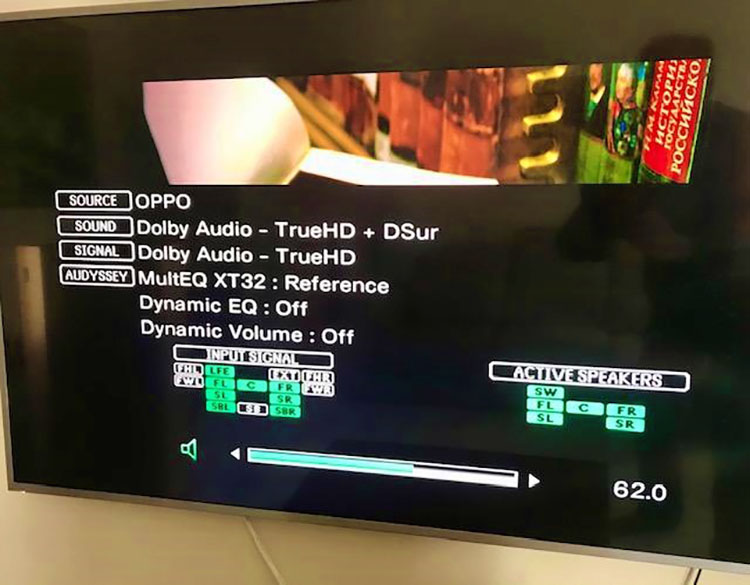
A flip-down cover on the front reveals the headphone and Audyssey mic jacks, zone controls, panel dimmer, audio mode selections, USB, and component A/V inputs. I found that I never had to open it once I ran the Audyssey setup because other than the headphone jack, all other features behind the panel were controlled by the remote.
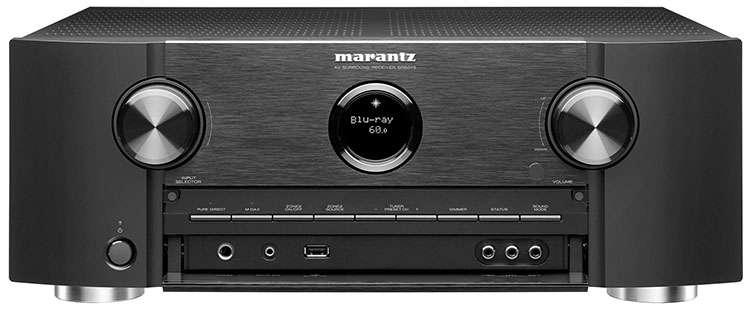
The back panel is tightly packed with eleven binding posts, seven HDMI inputs, and three outputs with one dedicated 8K input that supports 8K/60Hz and 4K/120Hz pass-through capability, 4:4:4 Pure Color sub-sampling, Dolby Vision, HLG, HDR10, 21:9 video, 3D and BT.2020 pass-through. I do not have an 8K HDTV yet, but I can verify that the SR6015 upconverted all my cable TV channels to 4K and the picture looked great, even with 720p as a source. If I had an 8K TV, it would upscale all video to 8K automatically. All HDMI inputs have HDCP 2.3, so they are ready for 8K (which will get a big sales boost in 2021, in my opinion). The receiver recognizes input devices and will automatically name them, though you can easily edit the input names to whatever you like. It correctly identified my OPPO UDP-203 and Android set-top box. You can use the SR6015 to test your HDMI cables by looping the output and input together and the display will tell you if the cable has the bandwidth for 4K or 8k. It is my understanding that an installer might have a device that does this too, but it can cost a few thousand dollars on its own. I am currently shopping for a new UHDTV and this feature may come in handy, though an 8K TV will probably be able to upscale as well or better than the receiver. In any case, if you are like me, I have a more modest 5.1 speaker setup and as much as I like some of the newer audio formats, there are only so many speakers I can cram onto my walls and ceiling.
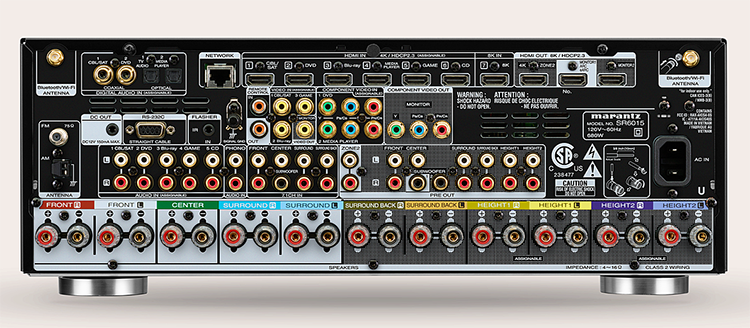
There is a 300+ page manual that comes in the form of a PDF which I downloaded to my desktop. It is a tough slog to read through, but in PDF form you can jump to a specific section by typing in keywords. The actual setup process was quite easy as each step is visually placed on the screen of your TV. Select how many speakers you are using and Audyssey walks you through the whole process. Even setting up dual subs in different locations was quick and easy. Using the remote, you can create up to four presets, so one can be for the home theater with Audyssey and another could be a two-channel setup without room correction. Or you can have room correction with the curtains open and yet another with all the curtains closed and a drop-down screen engaged for a movie. All these features can be assigned to a single button press. Though the receiver’s front panel display shows most of what’s going on, the on-screen version from the remote allows you to quickly see what processing is engaged for audio and video along with the input and output signal details. I found this feature to be much more useful than the receiver’s front panel display, which is difficult to see from across the room. Despite the complexity and enormous processing power of the SR6015, I was impressed with the actual ease of the setup process and feel that even a novice could do a good job by following the step-by-step instructions. Being able to switch Audyssey on and off made it easy to compare the difference in sound. I liked what it did for my room. For about $20, you can download the Audyssey Editor app to your iPhone and have even more ability to tweak away.
My one beef with the SR6015’s remote is that it is not backlit. Any video component has at least a fifty-fifty chance of being used in the dark. The remote should have a backlight. I have a Harmony remote that was a good workaround, but this oversight is a bit of a bummer for me. Otherwise, the remote is well laid out and all but guarantees that you will never have to get out of your lounger to make any adjustments on the SR6015.
My home theater consists of an OPPO UDP-203 UHD Blu-ray Player, PS Audio DSD DAC, Sonus faber Sonetto V front speakers, Revel C12 center channel and Revel S12 surrounds. Also included were Earthquake CP-8 wired and RSL Speedwoofer 10s wireless subwoofers. My room dimensions are a modest 13 by 17 feet.
Most of my stereo listening was via the PS Audio DSD DAC, while multichannel music was DSD played through the UDP-203. After running Audyssey with the supplied microphone and cardboard mic stand, I left the receiver in Reference mode for movies and DSD music. All stereo-only music was from Qobuz and sent to the SR6015 in analog direct. I do not like to take an analog signal and re-convert to PCM (in the receiver) only to then go back to analog. In direct mode, I lose the use of the subs, but the Sonettos can dig deep without any assistance from the subs anyway and I enjoy the open soundstage that direct mode provides.

Roxy Music, Avalon
Music listening was a little bit of everything from Classical and Jazz to Electronica and New Age. Roxy Music’s Avalon has an aggressive surround mix with cavernous bass. Ferry’s vocals were clear and prominent in the mix with the backing vocals well-spaced in the surrounds. The music swirls around you and wonderfully envelopes your mind and soul. The music is very beat-driven, yet relaxing and hypnotic. I liked what I was getting from the SR6015. Switching Audyssey on and off changed the timber and dimension; both ways sounded good, but I preferred the deeper sound stage that Audyssey MultEQ XT32 provided. The fronts, surrounds, and subs blended beautifully.

Yello, Toy
Toy, by Yello never fails to impress me with its pulsing bass and electronic dance rhythms. Even in stereo, it is hard not to imagine you are not playing a multichannel recording. The SR6015 rendered a wide and deep soundstage that was energetic and spacious. Though the sound of the Marantz was excellent from its internal amplification, I ultimately settled on an external amp because it afforded me a bit more headroom, and why not? I had the amplifier anyway.

John Williams, Vienna Philharmonic
Classical music came across with the dynamics you’d expect from an actual concert, with John Williams playing some of his greatest movie hits with the Vienna Philharmonic. Subtle nuances were ever-present in the quieter passages and the dynamic range was sometimes startling. Is the Marantz Sound better than say, a Denon receiver? I do not have one to compare, but from the SR6015, I was more than pleased with the sound quality. The only thing I can accurately compare it to would be my somewhat long-in-the-tooth Emotiva UMC-200 pre/pro. I can say the Marantz ran rings around it, but the Emotiva cost about a third of the price and had limited processor power, so a fair comparison it is not.

John Wick 3
Movies are what a serious processor is all about. Randomly sampling some boisterous blockbusters, I watched the closing fight at the Hotel Continental in John Wick 3. I was blown away (ha!) by the shotgun blasts. Playing through dual subs, the bass was punchy and tight. There is an Audyssey subwoofer mode that you can engage for late-night listening that prevents the deepest rumbles from going through floors and walls, but I never had occasion to use it.

Mad Max: Fury Road
Mad Max: Fury Road is a tour de force of action movies. Dialog remained distinct above the fray. Surrounds never seemed shy and the explosions were exhilarating. The SR6015 presented an excellent image in HDR10. Video quality was at least as good as I’ve seen when playing this movie directly to the screen from my OPPO. Regarding the HDMI 2.1 bug that caused issues with the new PlayStation 5: a December 10th software patch was released that resolved the issue. I appreciate Marantz for working on the problem as quickly as it came up (yes, this applies to Denon receivers as well).
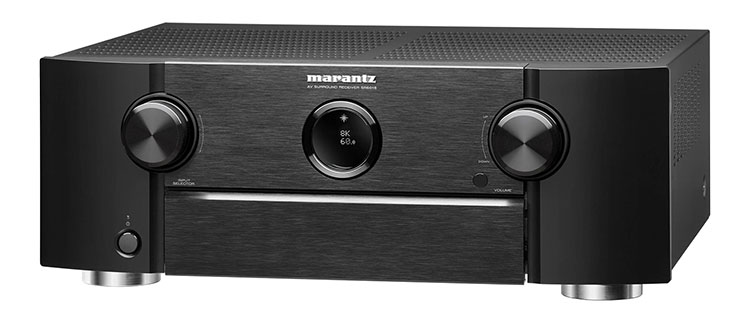
With the excellent sound quality and construction, the Marantz SR6015 is an easy recommendation for a music lover or a home theater enthusiast.
- Excellent sound quality
- Intuitive setup process
- Flexibility: Can be run as a preamp
- Audyssey MultEQ XT32
- Video support up to 4K/120Hz and 8K/60Hz
- Backlit remote
The Marantz SR6015 offers most of the features of the top-of-the-line SR8015 at a lower price point, but with slightly less muscle, while still providing a receiver that will not become obsolete anytime soon. You can use it as a preamp and add your own amplifiers, making the SR6015 as powerful as you wish. eARC and video upscaling are ready to launch you into an 8K world with high-resolution multichannel sound. With VRR and fast switching, gamers will be happy, too. The Marantz SR6015 delivers on both build and sound quality. I would recommend it to music lovers and videophiles as it is easy to set up and the menus are intuitive, so a novice need not be intimidated by it. Nothing is completely future proof, but the Marantz SR6015 should keep you happy for years to come.



